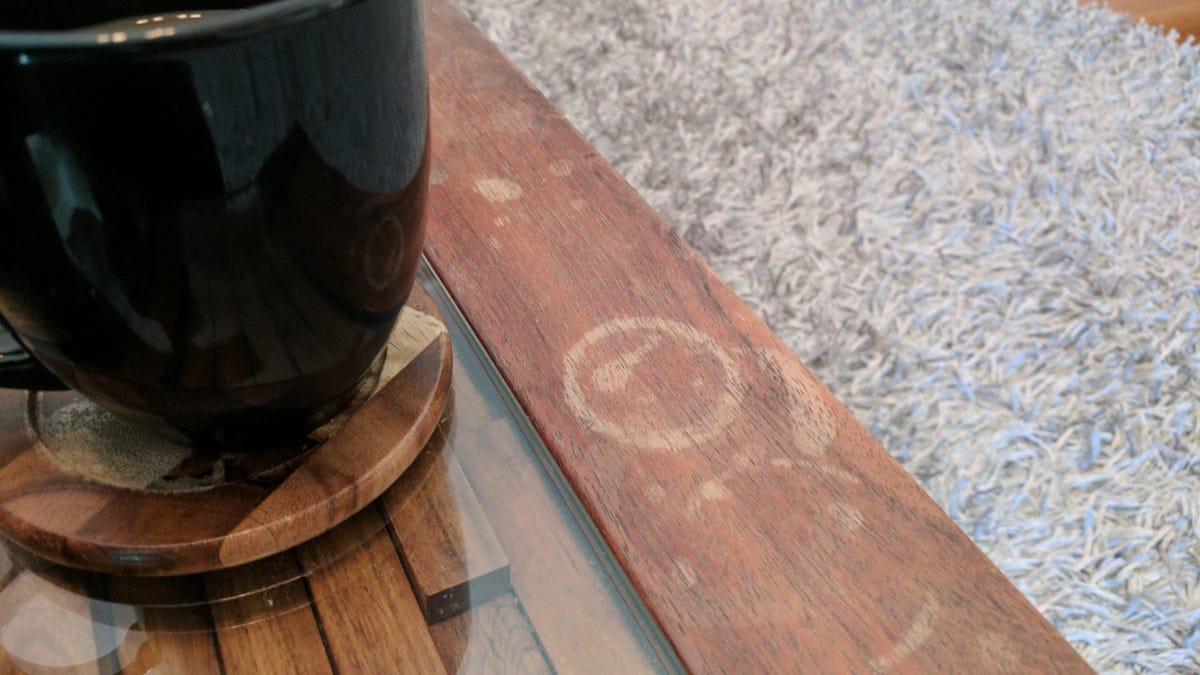The easy way to remove water stains from wood furniture
No need to go to the hardware store -- you have everything you need to remove water marks.

Nothing ruins the luster of wood furniture quite like a watermark.
Watermarks -- or water stains -- are often caused by cold glasses, spills, or hot dishes places directly on the wood. Luckily, though, they aren't always permanent.
This guide will guide you through the process of removing these stains. But first, remember: even a quick touch-up can damage an heirloom. So, follow the directions carefully and exercise patience when removing stains. For extra insurance, test the method on a hidden area before going all-out on the top surface of the wood.
Light white watermarks like these should be relatively easy to remove.
1. Identify the stain
Is the water stain white, dark brown or a shade of black? The stain color will determine how easy it is to treat and the methods you should use.
White stains. Lightly-colored marks, typically in the shape of rings, are caused by the bottoms of cold glasses or hot plates and mugs resting on a wood surface. In both cases water is the culprit, in the form of condensed moisture (cold) or steam (hot). This water pushes into the wood's finish below to cause the otherwise clear layer to turn white or a milky gray.
It sounds bad but it's actually less severe than you think. Because the moisture hasn't penetrated into the actual wood beneath the finish, it likely hasn't done irreversible damage.
Dark stains. A dark brown, or black mark indicates water has reached the wood itself so a quick fix isn't possible. Keep reading for a few tips you can try.
This water ring on my vintage turntable console is heartbreaking.
2. Light stain? All you need is an iron
A simple way to handle light watermarks is to expose it to gentle heat and pressure. For this you'll need an electric iron and a plain, non-abrasive cloth.
- With the iron set to its lowest heat level, lay the cloth across the stained area. Make sure all of the iron's steam modes are off. The last thing you want is to create more stains made from moisture and heat.
- Next, gently run the warm iron over the fabric making sure to move in the same direction with each pass.
- Lift the cloth to check periodically to see if you've made any progress, about every five passes or so. The wood's finish should gradually release trapped moisture, the cause of the watermark.
I personally tried the technique on my vintage turntable that's housed in a wooden console cabinet. Somehow a big, fat ring watermark had sprouted right on top of it -- no doubt from someone's stray Bourbon glass. Surprisingly after just a few minutes, and about 10 iron strokes later, the ring all but completely vanished.
Ironing the stain carefully (no steam) removed it almost entirely.
3. For dark stains, grab a toothbrush
Sometimes water sits on a wood surface long enough to seep past its protective finish and into the wood below. That's often the case with leaky planters, which can cause damage for months without anyone noticing. The result is typically a dark brown or black ring. Unfortunately, an iron can't cure this problem.
A dark water stain is harder to remove. Toothpaste often will do the trick, though.
Brush the stain gently because too much scrubbing will also remove the wood finish beneath.
Here's where an old toothbrush and a little plain, white toothpaste comes in handy.
The fix: Using a small dab of paste, gently brush the entire watermark. Make sure not press too hard or brush for too long or you risk removing the wood stain along with the watermark. Of course in many situations this outcome is unavoidable and the only remedy is a complete overhaul by a furniture restoration pro.
4. Maintain your wood furniture regularly
Even after successfully banishing those ungainly watermarks, wood furniture needs regular upkeep to stay looking their best. The most frequent task you'll need to perform is dusting with a soft, dry cloth. To limit unnecessary wear and tear don't dust often, once a month perhaps.
Another way to go is to dust wood with the help of a citrus oil such as Howard's Orange Oil. Products like these are designed to prevent wood from drying out and add shine. Do so infrequently though since excessive use will cause an unwanted built-up of dirt, dust, and oil. This is what the Smithsonian recommends and the museum knows a thing or two about caring for priceless wood objects.
Wood furniture needs a little love to look their best, but not too much.
5. No success? Consider these factors
There are countless additional factors that'll affect how well your watermark removal goes. For instance, whether the piece of furniture you plan to treat is made from soft pine wood, or hard woods like oak and rosewood. This also depends on and often determines how thin or thick the finish is and what substances were employed to create them. Examples include shellac, polyurethane and lacquers.
In these cases, you may need to take your furniture to an expert who can use other methods -- like restaining -- to remedy any watermarks.

